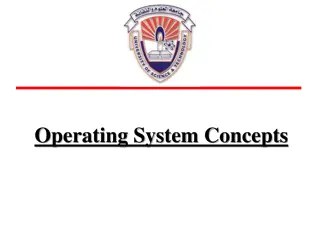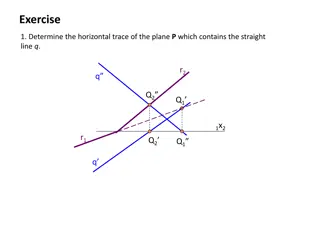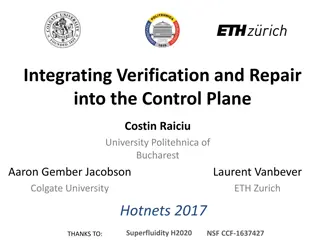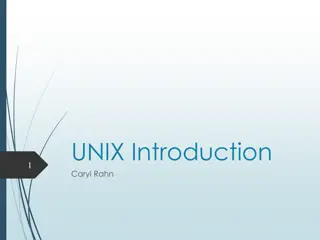Arrakis: The Operating System is the Control Plane
Arrakis is an innovative operating system that focuses on the control plane, designed to optimize performance in data centers by skipping the kernel for data-plane operations, retaining classical server OS features, and providing appropriate OS/hardware abstractions. It addresses slow system calls, hardware I/O virtualization, and traditional OS API limitations.
Download Presentation

Please find below an Image/Link to download the presentation.
The content on the website is provided AS IS for your information and personal use only. It may not be sold, licensed, or shared on other websites without obtaining consent from the author.If you encounter any issues during the download, it is possible that the publisher has removed the file from their server.
You are allowed to download the files provided on this website for personal or commercial use, subject to the condition that they are used lawfully. All files are the property of their respective owners.
The content on the website is provided AS IS for your information and personal use only. It may not be sold, licensed, or shared on other websites without obtaining consent from the author.
E N D
Presentation Transcript
Arrakis: The Operating System is the Control Plane Simon Peter, Jialin Li, Irene Zhang, Dan R. K. Ports, et al. presented by Jimmy You EECS 582 F16 1
Background Today s hardware is fast! Typical commodity desktop (Dell PowerEdge R520 ~$1000): 6-core CPU RAID w/ 1G cache ~25 us / 1KB write 10G NIC ~2us / 1KB pkt EECS 582 F16 2
Background But Data Center is not as fast as hardware. % of processing time (Redis NoSQL) read 8.7 us 163 us write 0% 20% 40% 60% 80% 100% Hardware Kernel App EECS 582 F16 3
Background Who is dragging? EECS 582 F16 4
Background Who is dragging? System Calls are slow: epoll : 27% time of read recv : 11% time of read send : 37% time of read fsync : 84% time of write EECS 582 F16 5
Motivation Design Goals: Skip kernel for data-plane operations (low overhead) Retain classical server OS features (transparency) Appropriate OS/hardware abstractions (virtualization) EECS 582 F16 6
Hardware I/O virtualization Already de facto on NICs Multiplexing: SR SR- -IOV Protection: IOMMU IOMMU (e.g. intel VT-d): devices use virtual memory of apps Packet Filter Packet Filter: control the I/O I/O Scheduling: Rate limiting, packet scheduling Rate limiting, packet scheduling IOV: split into virtual NICs, each w/ own queues, registers, etc. EECS 582 F16 7
Traditional OS API Multiplexing Naming Resource limit Access Ctrl I/O Scheduling Protection I/O Processing Apps Hardware Kernel Libs EECS 582 F16 8
Skipping the kernel API Multiplexing Naming Resource limit Access Ctrl I/O Scheduling Protection I/O Processing Apps Hardware Kernel Libs EECS 582 F16 9
Skipping the kernel API Multiplexing Naming Resource limit Access Ctrl I/O Scheduling Protection I/O Processing Apps Libs Hardware Kernel EECS 582 F16 10
Skipping the kernel Control Plane Data Plane Apps libos Control User Space Data HW Space Kernel Virtual Interface Control Data Hardware EECS 582 F16 11
Hardware Model NICs (Multiplexing, Protection, Scheduling) Storage VSIC (Virtual Storage Interface Controller) each w/ queues etc. VSA (Virtual Storage Areas) mapped to physical devices associated with VSICs VSA & VSIC : many-to-many mapping EECS 582 F16 12
Control Plane Interface VIC (Virtual Interface Card) Apps can create/delete VICs, associate them to doorbells doorbells (like interrupt?) associated with events on VICs filter creation e.g. create_filter(rx,*,tcp.port == 80) EECS 582 F16 13
Control Plane Features Access control enforced by filters infrequently invoked (during set-up etc.) Resource limiting send commands to hardware I/O schedulers Naming VFS in kernel actual storage implemented in apps EECS 582 F16 14
Network Data Interface Apps send/receive directly through sets of queues filters applied for multiplexing doorbell used for asynchronous notification (e.g. packet arrival) both native (w/ zero-copy) and POSIX are implemented EECS 582 F16 15
Storage Data Interface VSA supports read, write, flush persistent data structure (log, queue) modified Redis by 109 LOC operations immediately persistent on disk eliminate marshaling (layout in memory = in disk) data structure specific caching & early allocation EECS 582 W16 16
Evaluation 1. UDP echo server 2. Memcached key-value store 3. Redis NoSQL store 4. HTTP load balancer (haproxy) 5. IP-layer middle box 6. Performance isolation (rate limiting) EECS 582 W16 17
Case 1: UDP echo EECS 582 W16 18
Case 2: Memcached EECS 582 W16 19
Case 3: Redis NoSQL EECS 582 W16 20
Case 3: Redis NoSQL contd Reduced in-mem GET latency by 65% 9 us 4 us Linux Arrakis 0% 20% 40% 60% 80% 100% Hardware Kernel/libIO App Reduced persistent SET latency by 81% 163 us 31 us Linux Arrakis 0% 20% 40% 60% 80% 100% Hardware Kernel/libIO App Adapted from the original presentation at OSDI 14 EECS 582 W16 21
Case 4: HTTP load balancer (haproxy) EECS 582 W16 22
Case 5: IP-layer middlebox EECS 582 W16 23
Case 6: Performance Isolation EECS 582 W16 24
Conclusion Pros: much better raw Redis: up to 9x throughput and 81% speedup Memcached: scales to 3x throughput raw performance (for I/O intensive Data Center apps) Cons: some features require hardware functionality that is no yet available require modification of applications not clear about storage abstractions not easy to track behaviors inside the hardware EECS 582 W16 25
Discussion Related work (IX, Exokernel, Multikernel, etc.) Is Arrakis trading OS features for raw performance? How will new techniques change this trade-off? (SDN, NetFPGA) And of course, how much does raw performance matter? Security concerns EECS 582 W16 26
Related Work 90 s library Oses Exokernel Exokernel, SPIN, Nemesis Kernel-bypass U-Net, Infiniband, Netmap, Moneta-D High-performance I/O stacks mTCP, OpenOnLoad, Sandstorm, Aerie IX, Dune; Barrelfish (Multikernel) Adapted from the original presentation at OSDI 14 EECS 582 W16 27
IX, Arrakis, Exokernel, Multikernel Arrakis is like Exokernel built on Barrelfish (multikernel) IX Arrakis Reduce SysCall overhead Adaptive batching Run to completion No SysCall in data-plane Hardware virtualization No IOMMU No SR-IOV Expect more than what we have Enforcement of network I/O policy Under software control Rely on hardware EECS 582 W16 28
raw performance vs. (everything else) Two potential (and maybe diverging) direction: Be hardware-dependent (NetFPGA etc.) Be software-controllable (SDN etc.) 60 s switchboard operator Modern Operating Systems EECS 582 W16 29
Security concerns Will bypassing the kernel be safe? EECS 582 W16 30























